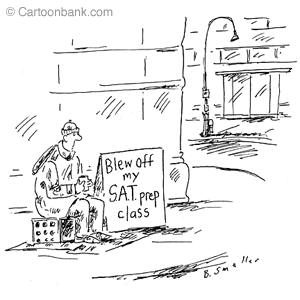October, 2009 archive
Editor’s Note 0
Chronicle of Higher Education Journalist, Eric Hoover, writes about something we have been sharing with our students for several years now. Â Mr. Hoover hits on all the important points very well.
Regardless of where your student applies the bottom line cost of college is of great importance, particularly in an uncertain economy. The increased number of applicants to state supported schools make even those “safeties” an uncertain option from an admissions perspective.
But there are still very good private colleges that offer non-need Merit Scholarships that are often not considered by bright, ambitious students. Too often they have constructed their college lists from the top down with “brand-name†colleges.
Though it is true that Harvard and Princeton have extraordinarly generous aid policies, a parent’s AGI needs to be less than $180,000 to qualify for significant need-based grants with one child in college. As we all know, however, the challenge is to be admitted in the first place.
In any case, our money saving Dry Run can give you an early look at the myriad of possibilities still available for both the student and parents.
College Admissions Uncertainty 0
The State of College Admissions: Full of Uncertainty
By Eric Hoover
As the numbers of college applicants and applications have gone up, many colleges have seen other things go down, including their acceptance rates, their “yield” rates, and their confidence in predicting enrollment outcomes.
A new report from the National Association for College Admission Counseling puts that trend in context. For the fourth straight year, about three-quarters of four-year colleges and universities saw an increase in applications over the previous year, says the report, which examined the admissions cycle for freshmen who enrolled in the fall of 2008. Twenty-two percent of those applicants had submitted seven or more applications, up from 19 percent in 2007.Â
 In an analysis of data from the U.S. Department of Education, the report’s authors also found that from 2001 to 2007, the average acceptance rate at four-year institutions fell to 66.8 percent, from 71.3 percent. During that time, the average yield rate—the percentage of admitted students who enroll—declined to 45.2 percent, from 49.1 percent. Read more »
US News 0
The popularity of the US News & World Report’s annual College Issue has spawned numerous copycats; each trying to offer its’ own spin on how it rates colleges. It’s all about selling magazines. Unit sales directly impacts advertising rates.
It’s more about the money than the value of the content. What does it really mean when you learn what the six year graduation rates are, the average financial aid a student receives, the student/faculty ratio, average SAT scores and average loan burden/student upon graduation?
It is interesting to see that more colleges are eschewing such assessments and not returning the self-reported questionnaires sent to them by the publications. Others are critical of their methods, but when a college is recognized in the “Top 10†or “Best of†in a particular category they are not shy about letting you know about it on their websites.
And yes, I am one of those who buy those magazines. I buy them because you are, and I want to be ready for your questions when you ask…
“Why do you recommend the 41st ranked University of the South @ Sewanee for Carolyn instead of the well known 18th ranked Colgate University?â€
I appreciate such questions. Â More often than not, the answer has to do with a combination of factors. The academic profile of the student and learning style, how a student expresses interest in different majors (however vague they may be early on), financial parameters of the parents, campus ethos and the nature of the academic and career advising.
All of which we take into account when suggesting the ‘starter list’ of fifteen colleges for a junior.  I invite you to arrange a FREE “get acquainted†conversation with us. We work with students all over the country (and in Europe) thanks to the Internet. Please click here for more information.
Editor’s Note 0
Recently we wrote about the confusion with the College Board’s policy on how to report SAT scores. Before that there was (and continues to be) confusion as to what strategy is best when applying to colleges. But now, the addled college applicant can encounter a maze of ever changing invididual college policies that can add to the mystery of college applications.
If after reading this report you have questions, do not hesitate to call or email. We have a special covert de-mystification method that will you enable you to see and think clearly.
SAT Test 0
SAT Test Optional or Not…the Debate Goes On
A year ago, the big news at the annual meeting of the National Association for College Admission Counseling was the release of a landmark report questioning the use of standardized testing. While the report did not call for testing to be abolished, it said that most colleges that required testing in the admissions process did not have a sufficient sense of its value, and the study suggested that careful analysis would lead many of those institutions to stop requiring the SAT or ACT as part of the admissions process. 
In the year since the report was released, there has been a steady stream (but not a wave) of movement away from testing requirements. Just in the week before the meeting, Sacred Heart University, the State University of New York at Potsdam and Washington and Jefferson College dropped SAT requirements. In the last year, new forms of going test-optional have also appeared. Some colleges — such as American University and the State University of New York at Geneseo — have gone test-optional for early decision applicants. Other institutions, such as New York University and Bryn Mawr College, moved in the last year to allow the use of SAT II (subject tests) or Advanced Placement tests instead of the SAT. Read more »
Visiting Colleges? 0
Looking Beyond the College Brochures
If you are serious about going to college, then you need to look beyond those expensive, glossy, full-color college brochures, or fancy websites, which tout the institution’s image and credentials.
Have you ever noticed that a lot of schools seem to have similar characteristics? … They are located in sun-drenched communities where clouds are rare… Classes are small and seminar-like and held on lush, green lawns… A beautiful lake is the visual center of most campuses; ducks and geese abound… It is fall year-round.
Don’t judge a college by its brochure. You must gather first-hand intelligence about the schools on your list. The summertime is the second-best time* for all you high-school juniors who are planning to visit colleges. Read more »
Editor’s Note 0
This year the College Board returned to its policy of years ago called Score Choice. When it was announced last year, my first thought was this only benefits the College Board, not the applicant. It has turned out to be, if not the worst decision, a most confusing one. Score Choice (which allows applicants to select which test results are reported … and which ones are not) was designed to help reduce student stress. But it has produced major headaches instead, especially because some colleges insist on seeing all scores, regardless of the Score Choice option.
This article from the Christian Science Monitor tries to explain how seniors should complete their Common Applications when they are applying to colleges that are honoring Score Choice and those that are not. However, it does not point out that once the Common Application is completed it is NOT necessary to send it to all colleges at the same time.
That is, the SAT scores (if below average for that school) can be edited out before sending to the SAT optional colleges. On the other hand, colleges like Yale that expect to see all SAT scores can be entered before submitting. By the way, if your high school puts ALL standardized test scores onto the official high school transcript, they may leave them off if you request it.
Although there are still many questions and concerns, that the new Score Choice policy evokes, this article should allay some worries about how to tackle the test-score section of the Common App this year.
Withholding SAT Scores 0
For Those Withholding SAT Scores, Advice on Completing the Common Application
 By Jacques Steinberg ÂAs high school seniors and their counselors get deeper into fall, they will surely find themselves wrestling with the fine print and ramifications of the College Board’s new Score Choice policy.
For the uninitiated, Score Choice is a new feature being offered by the College Board that allows applicants to withhold some SAT scores (presumably their lowest, though it’s not necessarily that simple) from the colleges to which they are applying. One potential complication: several dozen colleges, including Cornell, Rice, Tufts and Yale, require students to submit all SAT scores from every occasion in which they have taken the test.
Already, those seniors who have sought to get a jump on filling out the Common Application have been inundating the Common Application support center with questions related to Score Choice, and with reports that they are “flummoxed.†That’s the description Rob Killion, the executive director of the Common Application, used in an  e-mail message to me late Tuesday night. Read more »
Harvard University 0
The ‘Veritas’ About Harvard
by Kevin Carey,
Chronicle of Higher Education, October 1, 2009
What happens when the gods of high finance dump a gigantic pile of gold on the richest university in the world?
It sounds like the kind of hypothetical one might pose in a smoke-addled dorm room at 2 a.m. But it is, of course, what actually happened to Harvard University, along with a few of its elite competitors, over the last 20 years.
The answer is that the university reveals its true self. It shows the world what it cares about—and what it does not.
In 1990, Harvard had an endowment of about $4.7-billion. That was still a lot of money, about $7.7-billion in today’s dollars. Only five other universities have that much money now. Over the next two decades the pile grew to colossal heights, $36.9-billion by mid-2008.
Harvard spent the money on many things. But not a dollar went to increasing the number of undergraduates it chose to bless with a Harvard education. In 1990 the university welcomed slightly more than 1,600 students to its freshman class. In 2008, $32-billion later, it enrolled slightly more than 1,600 freshmen. Read more »


